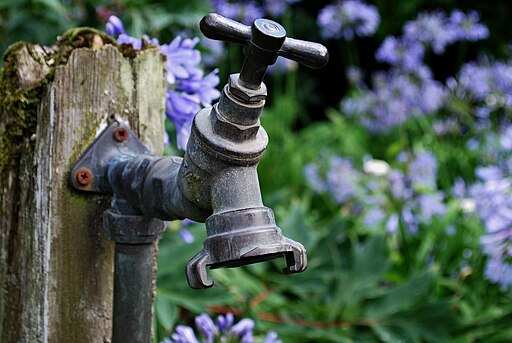 |
| Ye Olde Garden Tap |
Over the holiday break, I watered the plants at a friend's property while they were away interstate. Actually, I helped to ensure that the plants at another house were also watered by driving someone to that suburb as well. The family at that location had also decided to get away from the city for some respite. This is the first time that I have been so involved in caring for someone's else's garden while they were away. Usually, we are asked to look in after cats or budgies.
Not that that this was a terribly onerous thing to do. It was not. In fact, that is the surprise. It was a pleasant thing to do. I am not talking about the sense of companionship in absence that arises from doing a friend, or even complete strangers, a favor. That is one part of it. However, there was another very interesting dimension. It was the pleasure of caring for something that was growing and might otherwise die without my help.
I think it was the scale of the endeavor that caused me to notice it. I had taken care of pot plants for others while the were away. But, to care for a reasonable number of plants from seedlings to full-grown plants in their prime was an interesting experience. Again, it was more than the pleasure of watching my own efforts being rewarded. That is the point, there was little immediate reward.
In fact, the situation was somewhat counter-factual. Had I not watered, I would have seen the results in the wilted plants. Having watered, I was able to see the healthy plants continue in their health. I may be invited around for a salad or two in the future and I would be happy for that. But, such rewards are anticipatory and not immediate.
Having come from a working-class background, I might say that it was the pleasure of a job well done. But, the job involved very little skill. In the one case, it only required the willingness to drive to a spot and take the time to fill a watering can several times on a few occasions. In the other case, it merely required driving and dropping someone off while doing other chores and returning to pick that person up.
Without being corny, I think the pleasure was knowing that good was being done to the plants and that what was required of
necessity was being supplied accordingly. Deceptively simple. But, our culture tunes us out from noticing pleasure in a necessary act. We seem to be taught that only an absolutely free act, or a totally contingent act that we will is capable of bringing us pleasure.
It would seem that, apart from the impulse to shop or play a video game, there are very few opportunities for such conspicuous consumption of the totally contingent. We can do very little spontaneously these days. We have to get all the kit and paraphernalia out. Yet, if there can be pleasure in fulfilling necessities as a good in themselves and not merely because of the immediacy of companionship or some future gain, then the world becomes transformed in a fundamental way.
This is not to say that every necessity can be enjoyed in such a manner. Meeting some necissities requires courage and fortitude in the face of the unpleasant. But, if we increasingly take note of the times that some necessities are pleasurable as goods in themselves, then something of the spell of consumerism is at least diminished, if not broken.
I suppose it would be like changing from a diet of fast foods to eating more nutritious meals. At first, the new diet might seem boring and a chore done to achieve some other good. You do it as long as you get the long term results that you want. But, as time goes on, you begin to realize how good a salad can actually taste. Bread and legumes begin to interest you as flavorful and good in the actual eating. You move from merely dieting to eating well.
Thus, the new way becomes sustainable. I shall make the resolution to look for something similar while undertaking other necessities.
Attribution of Image:
By CathG (Own work) [CC-BY-SA-3.0 or GFDL], via Wikimedia Commons



